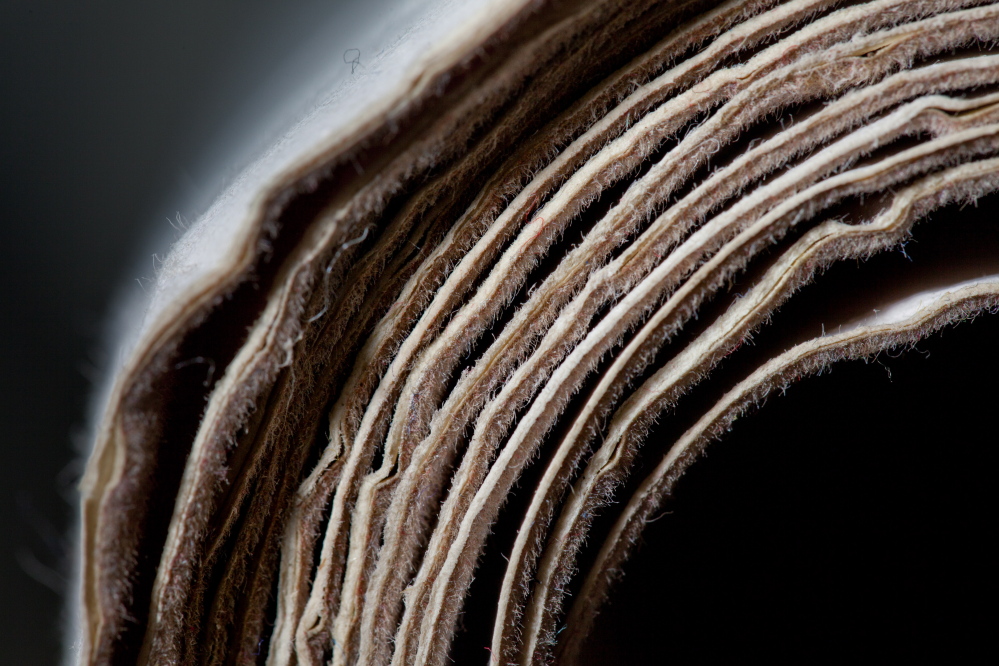It can be ripped in half or crumpled beyond repair by only the slightest slip of the hand, yet paper is likely the most powerful product to come out of Maine.
Its economic clout has been mighty, building entire towns in the midst of vast Maine forests and helping to lift countless Maine families into the middle class. Paper is one of the few man-made commodities that generations have cherished their whole lives, from the colored construction paper on which they first wrote “I love you mom” to their favorite books kept beside the bed in old age. Despite the explosion of information on computer screens, evocative phrases like “looks good on paper” or “turn the page” are strong reminders of how deeply paper is ingrained in our culture.
Right now, Maine’s ties to paper are coming undone. Verso’s paper mill in Bucksport is scheduled to close by the end of this year, and mills in Old Town and East Millinocket also shuttered in 2014. Every time a mill leaves, some of Maine’s cultural connections to paper go with it.
The economics of paper is taking it out of the state, maybe forever, at a time when society is already consuming much less of it. Yet people’s emotional ties to paper remain strong.
“When I was young, I didn’t know you had to buy paper. I just thought it was something Dad brought home the first Thursday of every month,” said Maine author Monica Wood, whose father worked for the Oxford Paper Co. in Rumford and Mexico. “Sometimes I wonder, if I had not grown up in a family where my father brought home these gorgeous packets of white, lovely paper once a month, would I have become a writer? When I open a book today I can stick my face in it and inhale my father, my childhood. It’s very emotional for me.”
For Wood, paper brings back vivid memories of her father and the job that put bread on her family’s table. But Maine paper, a product of the state’s dense forests and generations of Maine workers, has traveled the world and touched people’s lives in myriad ways for more than 100 years.
MAKING PAPER, MAKING MAINE
Papermaking began in Maine in the early 1700s, when the waters of the Presumpscot River in Westbrook were harnessed for a mill, according to the Maine Pulp & Paper Association. But little else is known of the early operation there. At the time, much of the papermaking in the Colonies was in New York, Massachusetts and Connecticut.
In the 1850s, a pioneer of Maine papermaking, Samuel Dennis Warren, bought the Westbrook mill for $28,000 and began the S.D. Warren paper company. The operation, still in Westbrook today, is now owned by Sappi.
In those early days, the S.D. Warren mill used papermaking methods of the time, turning discarded clothes and rags into pulp, instead of using wood. Around 1867, during a rag shortage, S.D. Warren began adding wood fibers to its pulp, as other Maine mills began using wood, too. Five years later, S.D. Warren had become one of the largest paper mills by volume produced in the world. The mill eventually employed several thousand people.
In the late 1800s, Maine started to attract other entrepreneurs who wanted to use the state’s vast forests for papermaking. One of those was Hugh J. Chisholm, born in Canada, who started the Otis Falls Pulp Co. in Jay around 1888. At the time the mill was built, it was already the third-largest paper mill in the country. A decade later, Chisholm became one of the founders of International Paper, with headquarters in Portland and mills all over Maine and the country. By the 1890s, there were nearly 40 pulp and paper mills in Maine, and the state led the nation in pulp production.
Maine paper carried postcard images and stories around the world. Around 1901, Oxford Paper in Rumford, owned by Chisholm, won a contract to supply all the postcards for the U.S. Post Office. The company turned out about 3 million postcards a day.
The state maintained its place as the top paper-producing state in the country for much of the first half of the 20th century, but lost that title to Wisconsin around 1960. The latter half of the 20th century saw a decline in Maine’s paper industry, as companies began to move production to states in the West and South, and later, to Asia. In recent years, the decline in demand for paper, coupled with a struggling economy, has led to the closing of Maine mills that we are witnessing today.
Still, at the start of the 21st century, Maine’s output remained the second largest of any state in the country, according to the state paper association.
And as late as 2012, Maine paper was part of a worldwide pop culture craze. The mill in East Millinocket hummed at maximum output that year, for one of the last times, thanks to a contract to produce 3,000 tons of paper to meet the incredible demand for the erotic romance novel “Fifty Shades of Grey.”
PAPER TOWN PRIDE
Part of paper’s mystique in Maine may come from the idea that in paper mill towns everyone from mill hands to managers worked toward something that benefited the whole community. If the mill thrived, the town thrived.
“I think at the time I was growing up there was much less disparity between how much money the people in charge made and what the workers made,” said Wood, who grew up in Mexico, across the river from Rumford.
Wood wrote a memoir, “When We Were the Kennedys,” about her family in Mexico around the time of her father’s death in 1963. Wood has also written a play that combines the emotions and economics of paper in Maine called “Papermaker,” to be presented by Portland Stage in April.
“Papermaker” is set during a paper workers’ strike in the late 1980s in the fictional Maine town of Abbott Falls, though Wood said it’s based on Rumford.
The play is about two families, one headed by the mill’s CEO and one headed by a worker. One theme of the play, Wood said, is the art of making paper, the idea that not just any “jamoke” off the street could do it.
Immigrants like Wood’s father, who came from a farm on Prince Edward Island in Canada, were able to make a good living by making paper. The Maine Pulp & Paper Association lists the 2011 average paper worker’s salary in Maine at about $64,000.
To celebrate Maine’s papermaking history, and especially what it meant to generations of workers and their families, longtime paper worker Sherry Judd started Maine’s Paper & Heritage Museum in Livermore Falls, around 2008. The volunteer-run museum, located in a house donated by International Paper, holds pictures and artifacts from paper mills around the state.
Judd said she wants future generations to remember what paper and paper mills meant to Maine.
“They were places where you could get very good jobs, where people made enough money to put their kids through college,” said Judd, 67, of Jay. “People took the mills very seriously, because that was their life.”
A SENSORY EXPERIENCE
The art of making paper is also what Bernard Vinzani celebrates, but on a very different level. Vinzani, who runs the University of Maine at Machias’ Book Arts program, makes paper by hand, as part of the process of making books by hand.
Vinzani makes paper the way it was made before machines began rumbling in Maine mills. He starts by choosing the fibers to make pulp out of – usually cotton or linen, not wood. He mashes the fibers to create pulp in something called a Hollander beater, a big tub with a metal wheel devised by the Dutch in the 1600s.
The fibers are dissolved in water, while Vinzani checks and adjusts the water’s acidity, and the pulp is laid out in a paperlike sheet on a screen to dry. Vinzani said he uses wool blankets to draw the moisture out of the fibers, which are pressed and dried. Vinzani likes that his paper comes out with an irregular edge, with a definite texture to it, and without the grain you see in machine-made paper.
“You can choose the fiber, the color, and make paper that suits the aesthetic of your text,” Vinzani said.
Vinzani collects paper and has handmade sheets from the 1300s that are “as crisp as the day they were made.” As a teacher, he points out that paper can be used to introduce students to a variety of subjects.
History students can discuss paper’s role in world events, Vinzani said. When machine paper first became viable in the 1800s, inventive entrepreneurs used it to create everything from coffins to shirt collars. It was vitally important during the Civil War, because it was used as a wrapping for various forms of ammunition.
“At one point, the Union troops were destroying the paper mills first when they came into a town,” Vinzani said.
Then there’s the science involved in making paper and the biology of the plants that are used. Not to mention the organic compounds created as paper degrades, or breaks down over time.
When people talk about how they enjoy the smell of a good book (and lots do), it’s not the dust or mold that they recall. They likely are talking about several compounds that are created as cellulose breaks down. These include benzaldehyde, which some say has an almond-like smell, or 2-ethylhexanol, which has a slightly floral scent.
Some people like to smell the paper in books because they want to fully drink in the power of that book. It’s something you rarely hear people say about Kindles.
“I just gave a book to my daughter, one that I loved, but before I gave it to her I wanted to give it one more good smell,” said Marie Caswell of Kennebunk, a sales representative at the Yarmouth pillow and comforter maker, Cuddledown. “I wanted to breathe in the scent of a favorite book.”
Unlike other iconic Maine products – blueberries, lobsters or L.L. Bean boots – paper is one of the few things made in Maine that most people touch every day.
There is truly a paper trail running through most of our lives, from birth certificates and first report cards, to favorite works of art, treasured love notes, and life-changing pieces of literature.
Ana Reeves, a librarian at Casco Public Library, talks about how many of us can measure time by the “paper moments that matter.”
One of those, she said, would be getting a book handed down to you that had been inscribed by a loved one or maybe someone you admire. Running your hands over a book like that, over the page with the signature especially, is an emotional experience that cannot be duplicated – and one that in many instances has been invisibly tied to the mills of Maine and the people who kept them running.
“There is some tangible memory there, a moment that means something and there just isn’t a digital equivalent, well, at least not yet,” Reeves said. “(There is) the sense that you are holding something held by someone who you loved or admired and you can feel that, and physically file that memory away.”
Send questions/comments to the editors.





